maintenance Seat Altea 2005 Service Manual
[x] Cancel search | Manufacturer: SEAT, Model Year: 2005, Model line: Altea, Model: Seat Altea 2005Pages: 286, PDF Size: 9.59 MB
Page 83 of 286
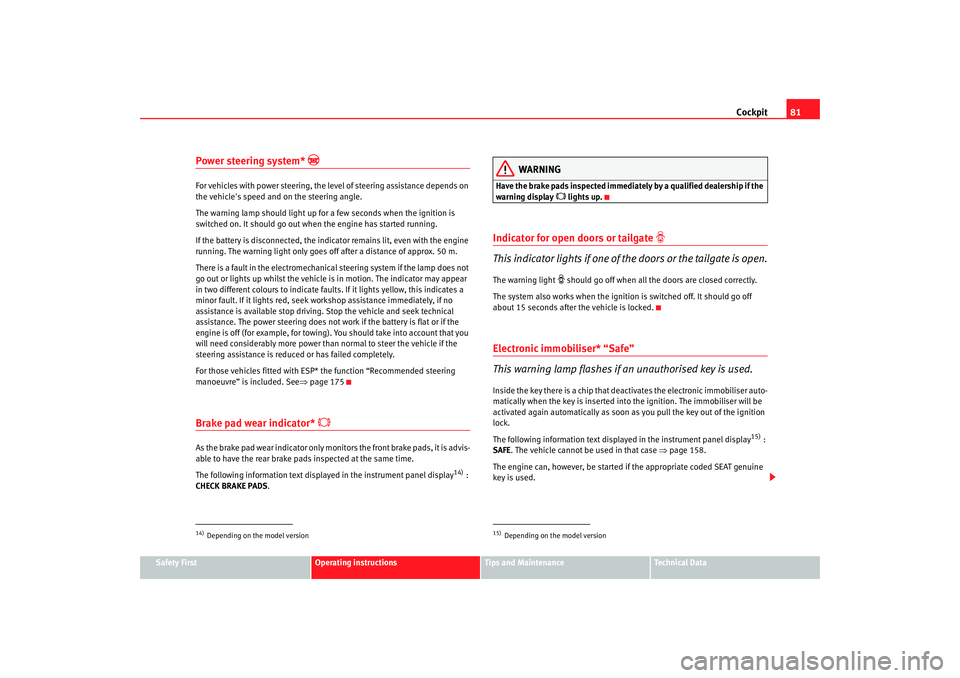
Cockpit81
Safety First
Operating instructions
Tips and Maintenance
Te c h n i c a l D a t a
Power steering system*
For vehicles with power steering, the level of steering assistance depends on
the vehicle's speed and on the steering angle.
The warning lamp should light up for a few seconds when the ignition is
switched on. It should go out when the engine has started running.
If the battery is disconnected, the indicator remains lit, even with the engine
running. The warning light only goes of f after a distance of approx. 50 m.
There is a fault in the electromechanica l steering system if the lamp does not
go out or lights up whilst the vehicle is in motion. The indicator may appear
in two different colours to indicate faults. If it lights yellow, this indicates a
minor fault. If it lights red, seek wo rkshop assistance immediately, if no
assistance is available stop driving. Stop the vehicle and seek technical
assistance. The power steering does not work if the battery is flat or if the
engine is off (for example, for towing). You should take into account that you
will need considerably more power than normal to steer the vehicle if the
steering assistance is reduced or has failed completely.
For those vehicles fitted with ESP* the function “Recommended steering
manoeuvre” is included. See⇒ page 175Brake pad wear indicator*
As the brake pad wear indicator only monitors the front brake pads, it is advis-
able to have the rear brake pads inspected at the same time.
The following information text displayed in the instrument panel display
14) :
CHECK BRAKE PADS .
WARNING
Have the brake pads inspected immediately by a qualified dealership if the
warning display
lights up.
Indicator for open doors or tailgate
This indicator lights if one of th e doors or the tailgate is open.The warning light
should go off when all the doors are closed correctly.
The system also works when the ignition is switched off. It should go off
about 15 seconds after the vehicle is locked.
Electronic immobiliser* “Safe”
This warning lamp flashes if an unauthorised key is used.Inside the key there is a chip that deactivates the electronic immobiliser auto-
matically when the key is inserted into the ignition. The immobiliser will be
activated again automatically as soon as you pull the key out of the ignition
lock.
The following information text displayed in the instrument panel display
15) :
SAFE . The vehicle cannot be used in that case ⇒page 158.
The engine can, however, be started if the appropriate coded SEAT genuine
key is used.
14)Depending on the model version
15)Depending on the model version
altea_ingles Seite 81 Donnerstag, 19. Mai 2005 3:02 15
Page 85 of 286
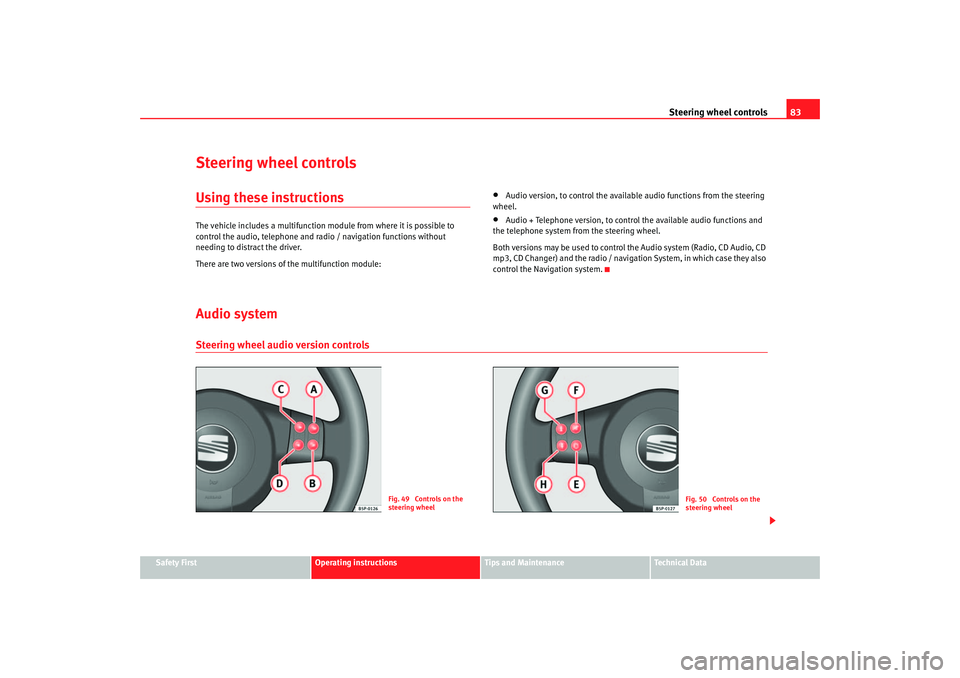
Steering wheel controls83
Safety First
Operating instructions
Tips and Maintenance
Te c h n i c a l D a t a
Steering wheel controlsUsing these instructionsThe vehicle includes a multifunction mo dule from where it is possible to
control the audio, telephone and radio / navigation functions without
needing to distract the driver.
There are two versions of the multifunction module:
•
Audio version, to control the available audio functions from the steering
wheel.
•
Audio + Telephone version, to control the available audio functions and
the telephone system from the steering wheel.
Both versions may be used to control the Audio system (Radio, CD Audio, CD
mp3, CD Changer) and the radio / naviga tion System, in which case they also
control the Navigation system.
Audio systemSteering wheel audio version controls
Fig. 49 Controls on the
steering wheel
Fig. 50 Controls on the
steering wheel
altea_ingles Seite 83 Donnerstag, 19. Mai 2005 3:02 15
Page 87 of 286
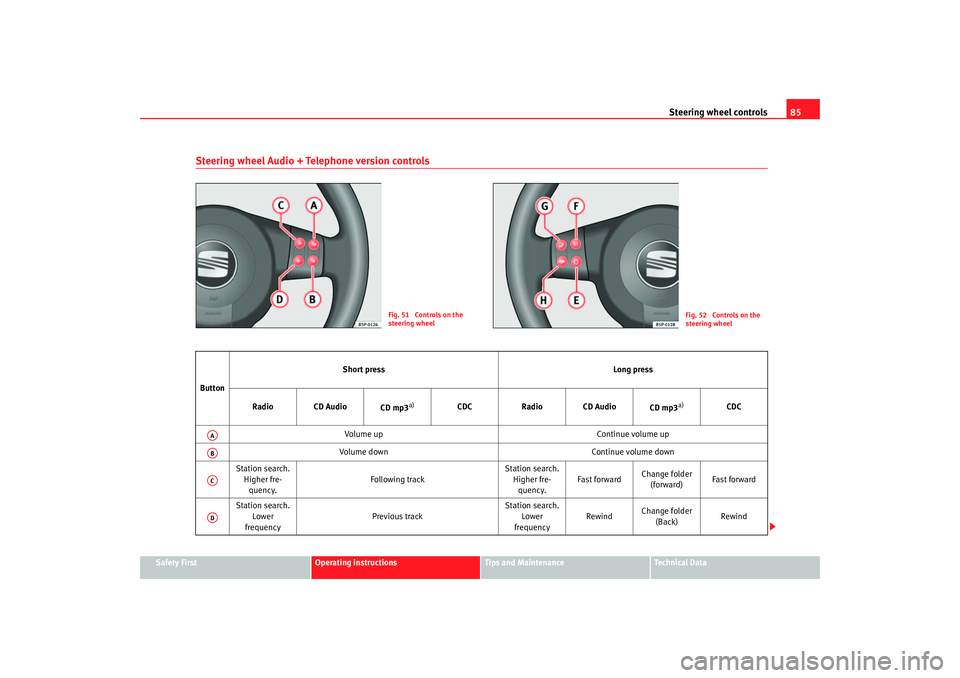
Steering wheel controls85
Safety First
Operating instructions
Tips and Maintenance
Te c h n i c a l D a t a
Steering wheel Audio + Telephone version controls
Fig. 51 Controls on the
steering wheel
Fig. 52 Controls on the
steering wheel
Button Short press
Long press
Radio CD Audio CD mp3
a)
CDCRadio CD Audio
CD mp3
a)
CDC
Volume up Continue volume up
Volume down Continue volume down
Station search. Higher fre-quency. Following track Station search.
Higher fre-quency. Fast forward
Change folder
(forward) Fast forward
Station search. Lower
frequency Previous track Station search.
Lower
frequency Rewind
Change folder
(Back) Rewind
AAABACAD
altea_ingles Seite 85 Donnerstag, 19. Mai 2005 3:02 15
Page 89 of 286
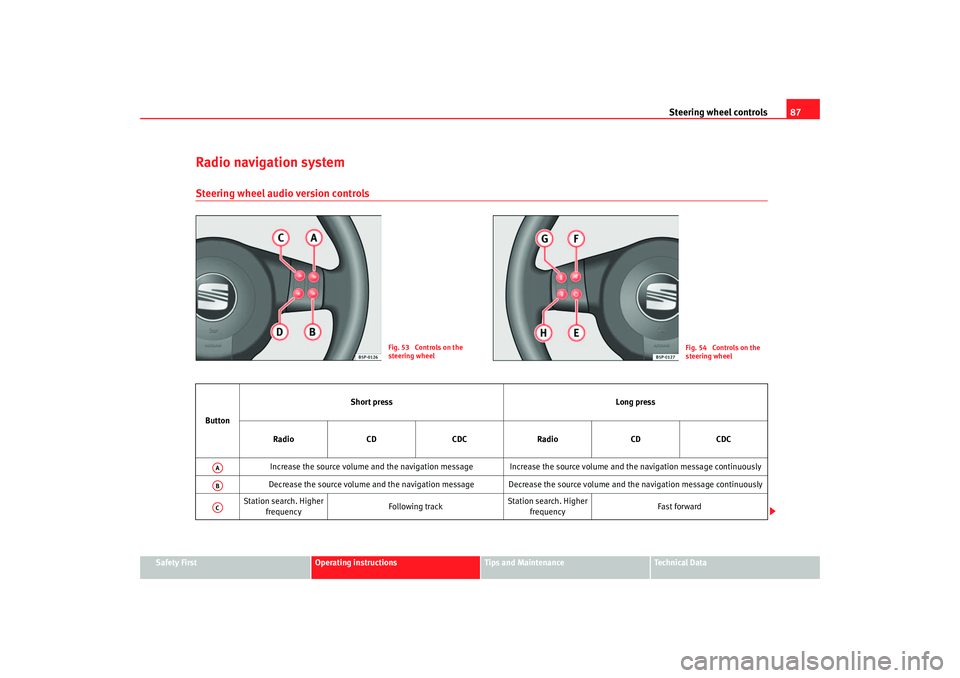
Steering wheel controls87
Safety First
Operating instructions
Tips and Maintenance
Te c h n i c a l D a t a
Radio navigation systemSteering wheel audio version controls
Fig. 53 Controls on the
steering wheel
Fig. 54 Controls on the
steering wheel
Button Short press
Long press
Radio CDCDCRadio CDCDC
Increase the source volume and the navigation message Increase the source volume and the navigation message continuously
Decrease the source volume and the navigation message Decrease the source volume and the navigation message continuously
Station search. Higher frequency Following trackStation search. Higher
frequency Fast forwardAAABAC
altea_ingles Seite 87 Donnerstag, 19. Mai 2005 3:02 15
Page 91 of 286
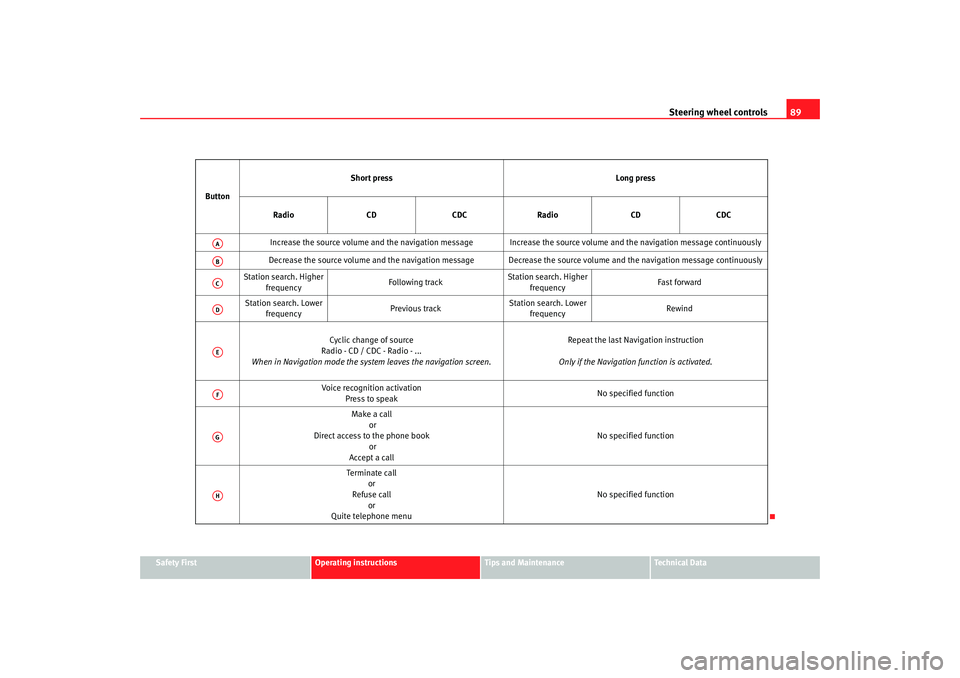
Steering wheel controls89
Safety First
Operating instructions
Tips and Maintenance
Te c h n i c a l D a t a
Button
Short press
Long press
Radio CDCDCRadio CDCDC
Increase the source volume and the navigation message Increase the source volume and the navigation message continuously
Decrease the source volume and the navigation message Decrease the source volume and the navigation message continuously
Station search. Higher frequency Following trackStation search. Higher
frequency Fast forward
Station search. Lower frequency Previous trackStation search. Lower
frequency Rewind
Cyclic change of source
Radio - CD / CDC - Radio - ...
When in Navigation mode the system leaves the navigation screen. Repeat the last Navigation instruction
Only if the Navigation function is activated.
Voice recognition activation Press to speak No specified function
Make a call or
Direct access to the phone book or
Accept a call No specified function
Terminate call or
Refuse call
or
Quite telephone menu No specified function
AAABACADAEAFAGAH
altea_ingles Seite 89 Donnerstag, 19. Mai 2005 3:02 15
Page 93 of 286

Opening and closing91
Safety First
Operating instructions
Tips and Maintenance
Te c h n i c a l D a t a
Opening and closingCentral lockingDescription
The central locking system enables you to lock and unlock all
the doors and the tailgate from one point.Central locking can be activated using any of the following options:•
the key, by inserting it into the driver's door cylinder and rotating manu-
ally,
•
the central locking button , (electronic control) in the passenger compart-
ment ⇒page 95 .
•
the radio frequency remote control , using the buttons on the key,
⇒ page 98
Various functions are available to improve the vehicle security:
- Locking system “Safe”
- Selective locking system*
- Locking system against involuntary opening
- Speed dependent locking and unlocking system*
- Safety unlocking systemNote
For anti-theft security, only the driver's door is fitted with a lock cylinder.
Safety system “Safe”
This is an anti-theft device consisting of a double lock for the
door locks and a deactivation func tion for the boot in order to
make forced entry more difficult.Activation
The “safe” system is activated when the vehicle is locked using the key or the
remote control.
To activate this system with the key, rotate the key once in the door lock
cylinder in the locking direction.
To activate the system using the remote control, press the lock button on the
remote once.
When this system is activated, it is not possible to open the doors normally,
from the outside or the inside. The boot/tailgate may not be opened. The
central locking button does not work.
Voluntary deactivation
The “Safe” system can be deactivated voluntarily by the user.
This is done by locking two times in quick succession (in under 2 seconds).
This double locking can be executed using the key or the remote control.
Using the key, rotate the lock cylinder twice in the locking direction.
To activate the system using the remote control, press the lock button on the
remote twice.
When the “Safe” system is deactivated, the alarm volumetric sensor is also
deactivated.
altea_ingles Seite 91 Donnerstag, 19. Mai 2005 3:02 15
Page 95 of 286
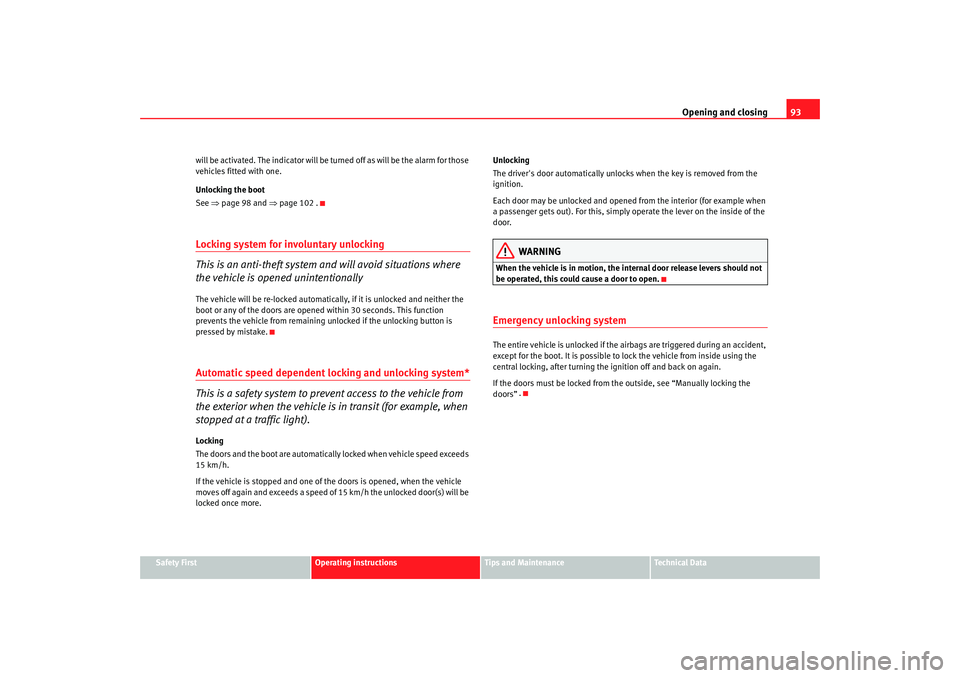
Opening and closing93
Safety First
Operating instructions
Tips and Maintenance
Te c h n i c a l D a t a
will be activated. The indicator will be
turned off as will be the alarm for those
vehicles fitted with one.
Unlocking the boot
See ⇒page 98 and ⇒page 102 .
Locking system for involuntary unlocking
This is an anti-theft system and will avoid situations where
the vehicle is opened unintentionallyThe vehicle will be re-locked automatically, if it is unlocked and neither the
boot or any of the doors are opened within 30 seconds. This function
prevents the vehicle from remaining unlocked if the unlocking button is
pressed by mistake.Automatic speed dependent locking and unlocking system*
This is a safety system to prevent access to the vehicle from
the exterior when the vehicle is in transit (for example, when
stopped at a traffic light).Locking
The doors and the boot are automatically locked when vehicle speed exceeds
15 km/h.
If the vehicle is stopped and one of the doors is opened, when the vehicle
moves off again and exceeds a speed of 15 km/h the unlocked door(s) will be
locked once more. Unlocking
The driver's door automatically unlocks when the key is removed from the
ignition.
Each door may be unlocked and opened
from the interior (for example when
a passenger gets out). For this, simply operate the lever on the inside of the
door.
WARNING
When the vehicle is in motion, the inte rnal door release levers should not
be operated, this could cause a door to open.Emergency unlocking systemThe entire vehicle is unlocked if the airbags are triggered during an accident,
except for the boot. It is possible to lock the vehicle from inside using the
central locking, after turning the ignition of f and back on again.
If the doors must be locked from the outside, see “Manually locking the
doors” .
altea_ingles Seite 93 Donnerstag, 19. Mai 2005 3:02 15
Page 97 of 286
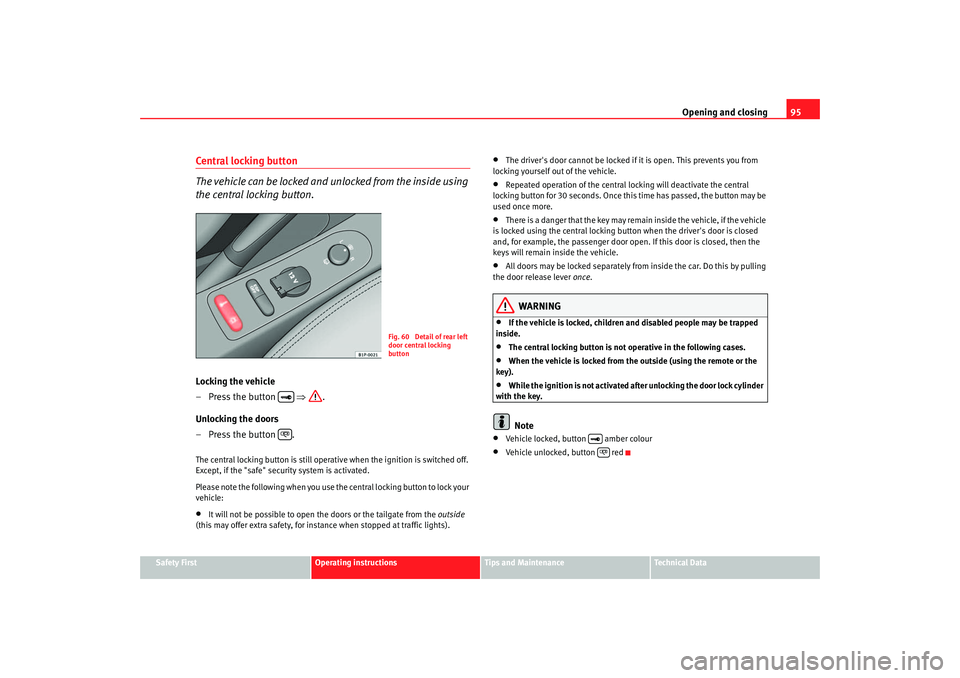
Opening and closing95
Safety First
Operating instructions
Tips and Maintenance
Te c h n i c a l D a t a
Central locking button
The vehicle can be locked and unlocked from the inside using
the central locking button.Locking the vehicle
– Press the button ⇒ .
Unlocking the doors
– Press the button .The central locking button is still operative when the ignition is switched off.
Except, if the "safe" security system is activated.
Please note the following when you use the central locking button to lock your
vehicle:•
It will not be possible to open the doors or the tailgate from the outside
(this may offer extra safety, for instance when stopped at traffic lights).
•
The driver's door cannot be locked if it is open. This prevents you from
locking yourself out of the vehicle.
•
Repeated operation of the central locking will deactivate the central
locking button for 30 seconds. Once this time has passed, the button may be
used once more.
•
There is a danger that the key may remain inside the vehicle, if the vehicle
is locked using the central locking button when the driver's door is closed
and, for example, the passenger door op en. If this door is closed, then the
keys will remain inside the vehicle.
•
All doors may be locked separately from inside the car. Do this by pulling
the door release lever once.
WARNING
•
If the vehicle is locked, children and disabled people may be trapped
inside.
•
The central locking button is not operative in the following cases.
•
When the vehicle is locked from th e outside (using the remote or the
key).
•
While the ignition is not activated after unlocking the door lock cylinder
with the key.Note
•
Vehicle locked, button amber colour
•
Vehicle unlocked, button red
Fig. 60 Detail of rear left
door central locking
button
altea_ingles Seite 95 Donnerstag, 19. Mai 2005 3:02 15
Page 99 of 286
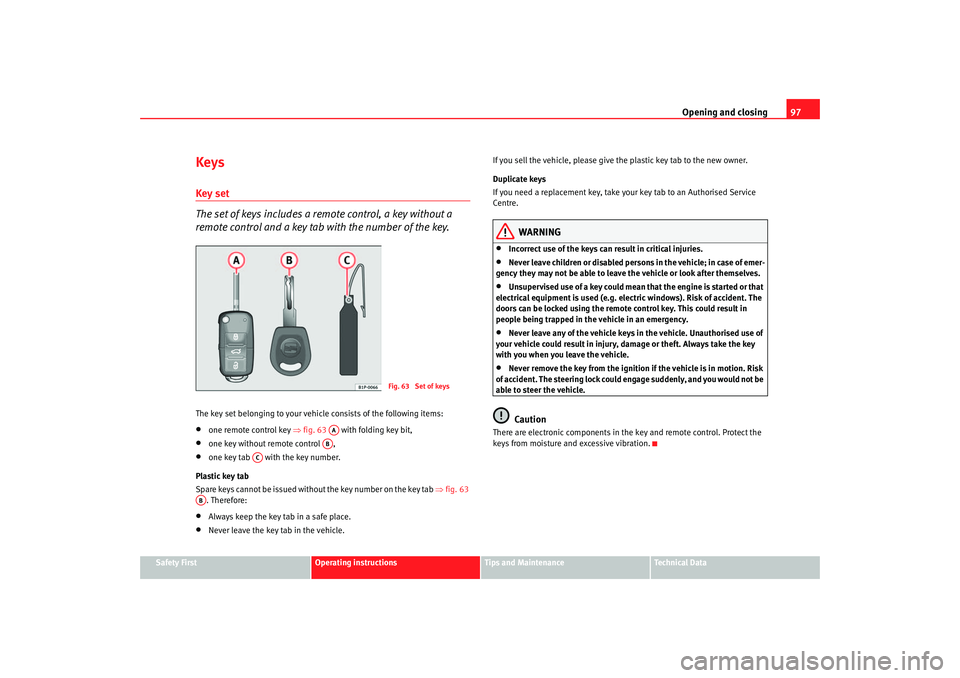
Opening and closing97
Safety First
Operating instructions
Tips and Maintenance
Te c h n i c a l D a t a
KeysKey set
The set of keys includes a remote control, a key without a
remote control and a key tab with the number of the key.The key set belonging to your vehicle consists of the following items:•
one remote control key ⇒fig. 63 with folding key bit,
•
one key without remote control ,
•
one key tab with the key number.
Plastic key tab
Spare keys cannot be issued with out the key number on the key tab ⇒fig. 63
. Therefore:
•
Always keep the key tab in a safe place.
•
Never leave the key tab in the vehicle. If you sell the vehicle, please give the plastic key tab to the new owner.
Duplicate keys
If you need a replacement key, take y
our key tab to an Authorised Service
Centre.
WARNING
•
Incorrect use of the keys can result in critical injuries.
•
Never leave children or disabled persons in the vehicle; in case of emer-
gency they may not be able to leave the vehicle or look after themselves.
•
Unsupervised use of a key could mean that the engine is started or that
electrical equipment is used (e.g. elec tric windows). Risk of accident. The
doors can be locked using the remote control key. This could result in
people being trapped in the vehicle in an emergency.
•
Never leave any of the vehicle keys in the vehicle. Unauthorised use of
your vehicle could result in injury, damage or theft. Always take the key
with you when you leave the vehicle.
•
Never remove the key from the ignition if the vehicle is in motion. Risk
of accident. The steering lock could engage suddenly, and you would not be
able to steer the vehicle.Caution
There are electronic compon ents in the key and remote control. Protect the
keys from moisture and excessive vibration.
Fig. 63 Set of keys
AAAB
AC
AB
altea_ingles Seite 97 Donnerstag, 19. Mai 2005 3:02 15
Page 101 of 286
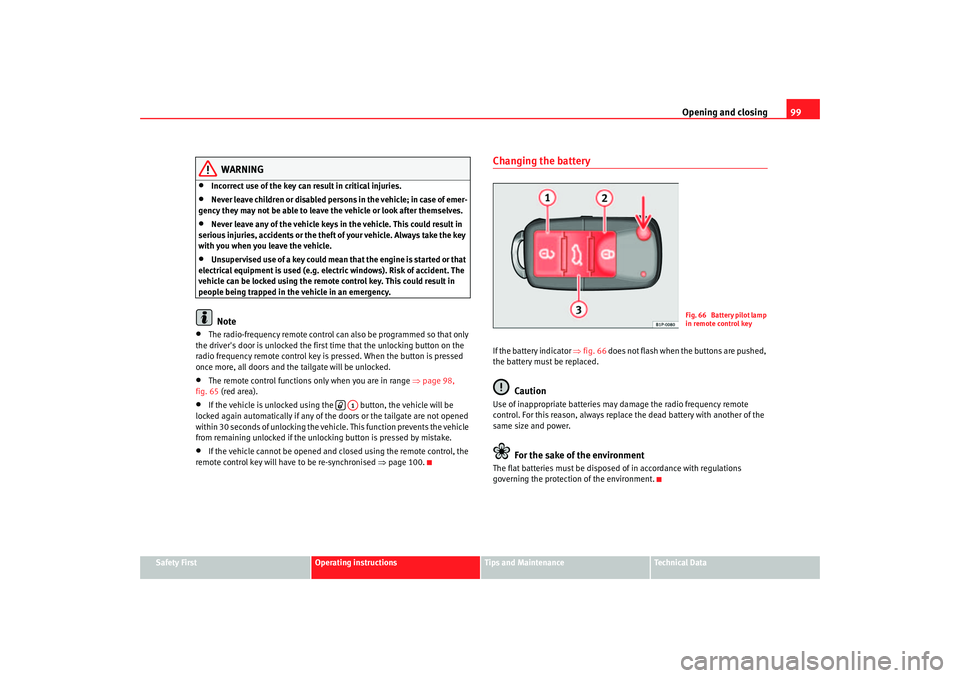
Opening and closing99
Safety First
Operating instructions
Tips and Maintenance
Te c h n i c a l D a t a
WARNING
•
Incorrect use of the key can result in critical injuries.
•
Never leave children or disabled persons in the vehicle; in case of emer-
gency they may not be able to leave the vehicle or look after themselves.
•
Never leave any of the vehicle keys in the vehicle. This could result in
serious injuries, accidents or the theft of your vehicle. Always take the key
with you when you leave the vehicle.
•
Unsupervised use of a key could me an that the engine is started or that
electrical equipment is used (e.g. elec tric windows). Risk of accident. The
vehicle can be locked using the remote control key. This could result in
people being trapped in the vehicle in an emergency.Note
•
The radio-frequency remote control ca n also be programmed so that only
the driver's door is unlocked the first time that the unlocking button on the
radio frequency remote control key is pressed. When the button is pressed
once more, all doors and the tailgate will be unlocked.
•
The remote control functions only when you are in range ⇒page 98,
fig. 65 (red area).
•
If the vehicle is unlocked using th e button, the vehicle will be
locked again automatically if any of the doors or the tailgate are not opened
within 30 seconds of unlocking the vehicle. This function prevents the vehicle
from remaining unlocked if the unlocking button is pressed by mistake.
•
If the vehicle cannot be opened and closed using the remote control, the
remote control key will have to be re-synchronised ⇒page 100.
Changing the batteryIf the battery indicator ⇒ fig. 66 does not flash when the buttons are pushed,
the battery must be replaced.
Caution
Use of inappropriate batteries may damage the radio frequency remote
control. For this reason, always replac e the dead battery with another of the
same size and power.
For the sake of the environment
The flat batteries must be disposed of in accordance with regulations
governing the protection of the environment.
A1
Fig. 66 Battery pilot lamp
in remote control key
altea_ingles Seite 99 Donnerstag, 19. Mai 2005 3:02 15